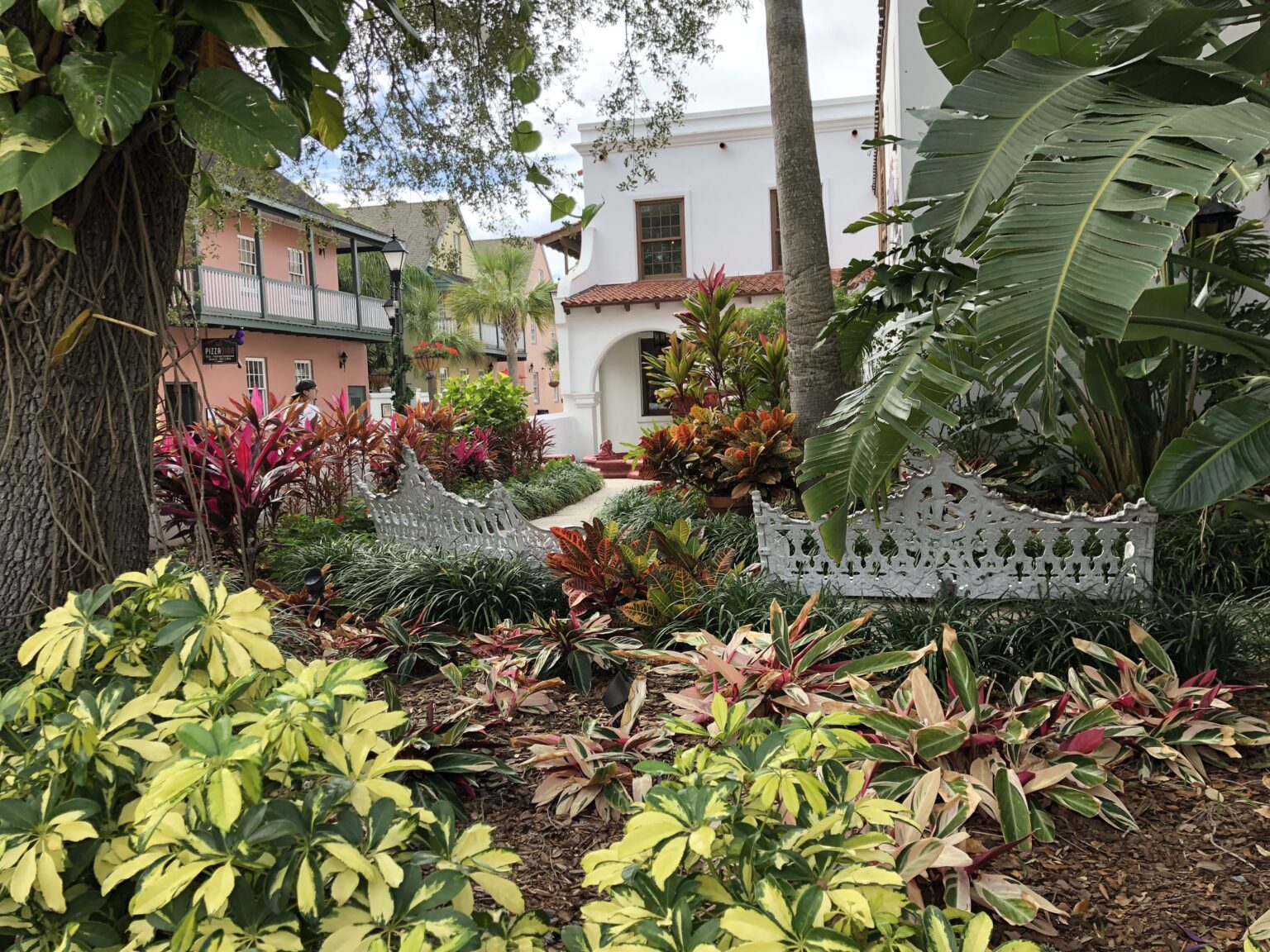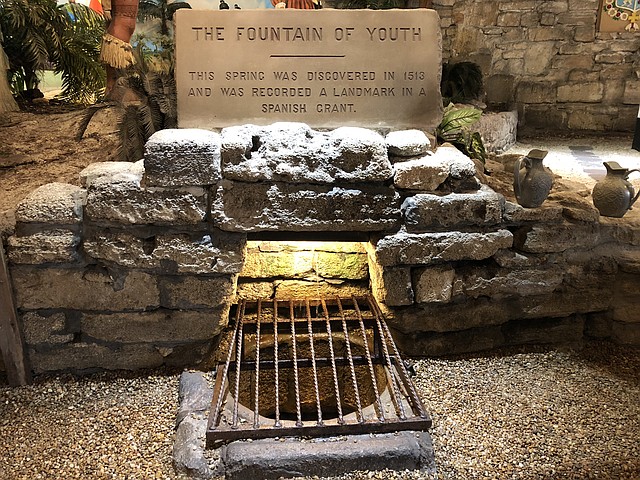
I greedily drank from the Fountain of Youth and patiently waited, but, alas, the wrinkles and crow’s feet remained etched on my face. The magical spring that was said to restore the youth of anyone who drinks or bathes in its waters didn’t have the powers of transformation I had hoped it would, but I could see how such a belief would motivate Spanish explorer Juan Ponce de Leon back in 1513. Imagine what it would be like to have the wisdom that comes with age and the vibrant exuberance that represents youth? No need for creams and lotions, or Botox and facelifts! The famed conquistador was so obsessed with discovering these special waters that he set sail from Puerto Rico determined to find them, and landed on the coastline of St. Augustine, Florida, in what is now known as Ponce De Leon’s Fountain of Youth Archaeological Park.
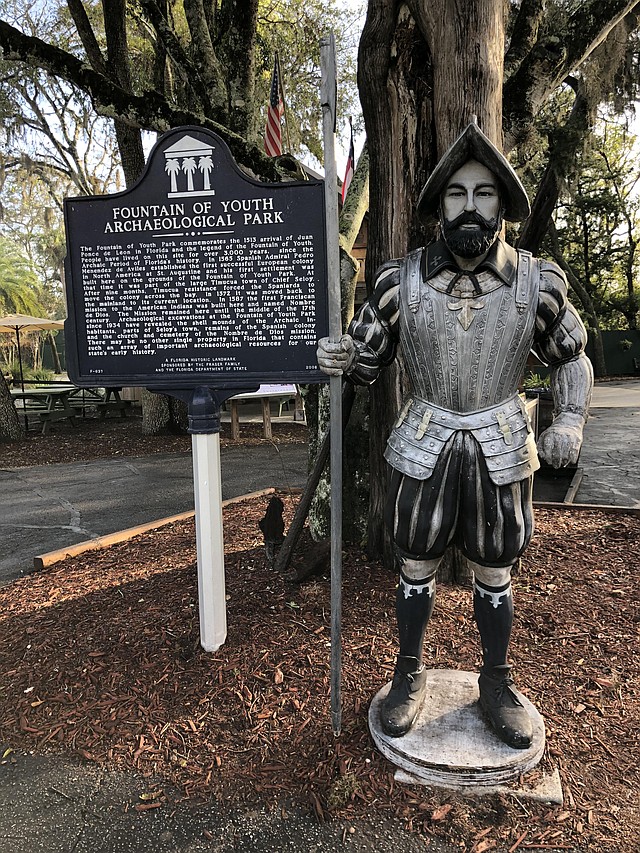
The park’s colorful history dates back more than five centuries. It’s the original site of Spanish Colonial St. Augustine, the first successful European settlement in the U.S., which was founded by Pedro Menendez de Avilés, a whopping 55 years before the Pilgrims landed on Plymouth Rock. The list of historical firsts in the park is impressive and includes the 1587 Mission of Nombre de Dios Church, the first Christian church built in the continental U.S. Additionally, the first documented Thanksgiving feast between Europeans and Native Americans occurred here. This site is also Florida’s oldest attraction with signed guest books that go back to 1867. Today, visitors can enjoy the park’s numerous exhibits and educational presentations on everything from archaeological research and nautical traditions to live cannon and weapons demonstrations. And, yes, you can still drink from the waters. Perhaps, you’ll have better luck than I when it comes to results! One thing is for certain: the springs that brought Ponce de Leon to Florida’s shores were valuable hydration sources for the Timucuan Indians for several thousand years and later served as impetus for Menendez’s settlement. They have brought the city much fame and plenty of bragging rights.
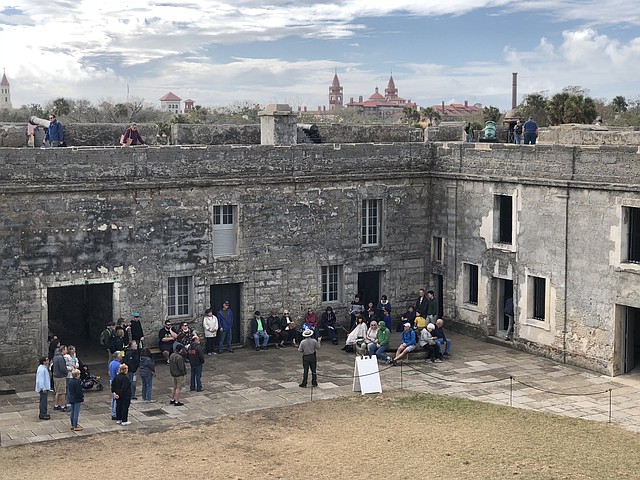
St. Augustine is a treasure trove of historical attractions with more than sixty points of interest. Two National Monuments reflect the prevalent Spanish and Minorcan heritage: The Castillo de San Marcos (1695), the nation’s oldest masonry fortress, and Fort Matanzas (1742), which guarded the city’s southern river approach, as European nations battled for power and control of the area. Currently, the latter, reachable only by ferry, is closed as both the boat and dock was damaged during Hurricane Irma. However, the visitor center and surrounding grounds remain open.
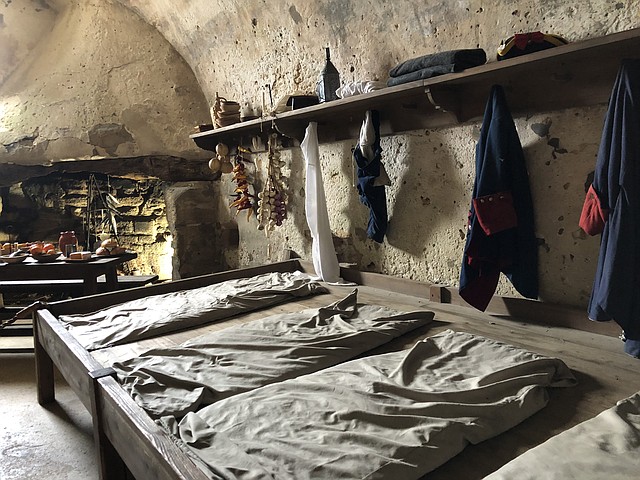
As you approach the Castillo de San Marcos, you’ll see a moat surrounding the place. The Spanish kept it dry and during sieges, used it as a pen for domestic animals. Note the drawbridge and the portcullis, the heavy sliding door, which is an indication of the building’s strength. Built of coquina stone, an almost indestructible material, the fortress stood as a mighty sentinel and served as a military warehouse, as well as a refuge for the townspeople. Inside, several exhibits introduce visitors to the Castillo’s history, design and construction, with rooms dedicated to guards’ quarters and ammunition storage. There’s also a chapel, where a priest conducted mass for the soldiers. The British Room is indicative of the period (1763-1784) when British troops moved to St. Augustine after Spain ceded Florida to Great Britain in exchange for the city of La Habana, Cuba. Outside, make sure to climb the stairs to the tops of the bastions and look out upon the waters of Matanzas Bay. From this commanding position, a garrison of Spanish troops safeguarded St. Augustine during the turbulent colonial era. Later English and then American troops also saw service here. All stood watch faithfully over the land Ponce de León named “La Florida.”
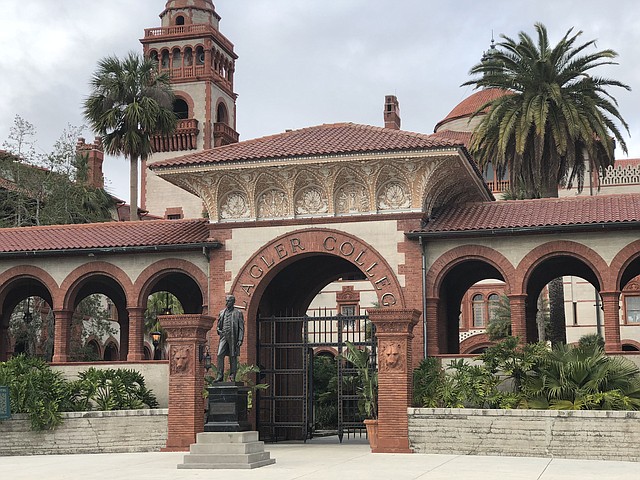
History buffs will also enjoy a guided tour of historic Flagler College. Built in 1888 by railroad magnate and Standard Oil co-founder Henry Flagler, the place began as St. Augustine’s Hotel Ponce de Leon. It was an exclusive resort property like none other and an architectural wonder where presidents stayed and the wealthy played. The entire structure was completed in only eighteen months at a cost of $2.5 million, and was wired for electricity by Edison himself. Designed in the Spanish Renaissance style by a prominent New York architectural firm, it features four different themes: nautical, Spanish, religion and the lion. You will notice representations of frogs, turtles, Spanish flags and coats of arms, angels and cherubs, ships and dates of explorations, lions and other symbols scattered throughout the property. The main lobby boasts carved oak pillars and a domed ceiling painted in twenty-four carat gold leaf. The floors are made of hand laid African mosaic title. If you look closely, you’ll see that there are a few imperfections in the tile. These flaws were purposefully created because according to Flagler, “only God is perfect.”
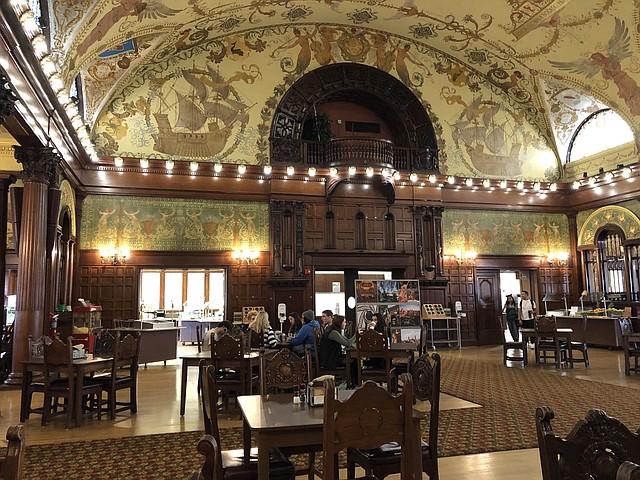
The ballroom, now the college’s dining hall, has the largest collection of Tiffany windows in the world. And the Flagler Room, the piece de resistance, is decked out in Tiffany chandeliers and coated in Tiffany paint. This room was once the Ladies Parlor, where women would come for tea upon arrival, while their husbands dealt with payment in another area. The doors were purposefully thick to shield the women from hearing any conversations about money. The belief of the day was that womenfolk had weak constitutions and would faint if they were privy to such matters. Take a moment to look at the portraits of Henry and his wife Mary. Because she was so much younger than him, Henry insisted that her portrait reflect his wrinkles!
The hotel closed in 1967 due to a decline in profitability. A year later, Flagler College was established, first as an all-women’s institution; later, it became coed. Today, there are 2,600 students attending the four-year private liberal arts school. It offers thirty-three majors and is especially known for the strength of its education and business administration fields of study.
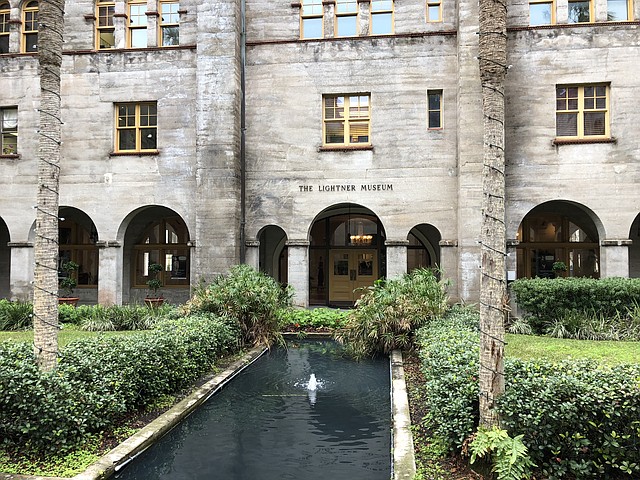
Across the street is the Lightner Museum, once the grand Alcazar Hotel of the Gilded Age, another of Flagler’s projects. This property featured the largest indoor swimming pool at the time, a grand ballroom, sulfur baths, a steam room, massage parlor, tennis courts, bowling alley and gymnasium. The hotel became a museum in 1948 when Otto Lightner purchased it. Lightner was a collector, who believed “everyone should have a hobby” and “everyone should collect something.” When Chicago mansions were put up for sale during the 1930s, he had the opportunity to buy treasures for low prices. Soon his possessions outgrew his Chicago museum-home. While in Florida for health reasons, Lightner noticed the vacant Alcazar Hotel and decided to buy it as a showcase for his collections.
The museum consists of several galleries on four floors, with displays of artwork, antiques and curios from the 19th century. Lightner’s collection is impressive and extensive. It includes such eclectic pieces as a mummy, shrunken heads, human hair art, cigar labels, salt and pepper shakers, Tiffany glass, porcelain, fine art paintings, furniture and sculpture.
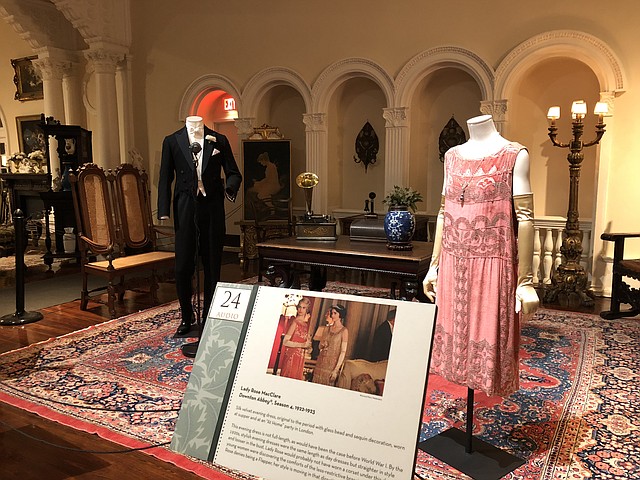
A recent special exhibition, “Dressing Downton: Changing Fashion for Changing Times,” was a crowd favorite at the museum. The costumes came from the wildly popular British period drama, “Downton Abbey,” an award-winning series that was recognized for its outstanding costume design, among other distinctions. The exhibition explored fashions in Britain between 1912, the year the Titanic sank, and the early 1920s, the dawn of the Jazz Age. By showing period costumes in historical context, visitors were able to see the progression of style in the country. Thirty-six costumes and accessories (both those worn by the aristocratic inhabitants of the show and those of their servants) were paired to perfection within engaging vignettes, immersed amid pieces of Lightner’s collection. It was a masterful presentation of costume history surrounding WWI, an era that changed the social fabric of Great Britain.
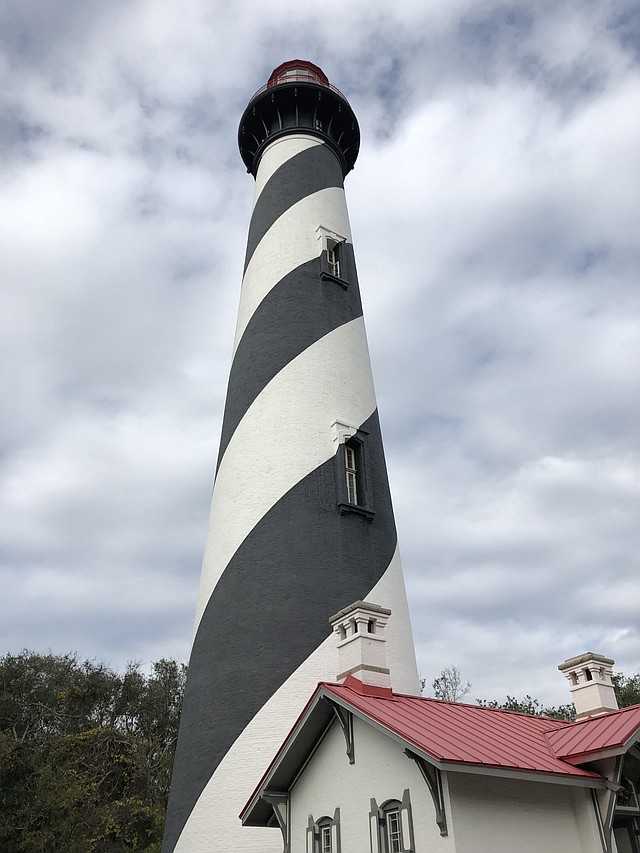
The St. Augustine Lighthouse & Maritime Museum is often at the top of many visitors’ lists of attractions. This light station has been host to centuries of maritime history and is a unique landmark and pivotal navigation tool that still remains in working order today. Climb the lighthouse’s 219 steps to the top for a breathtaking 360 degree view of the city, the Intracoastal Waterway and Atlantic Ocean. Ascend another twelve stairs to enter the lens room, where you can see the original 1874 Fresnel lens. It stands nine feet tall and was built from 370 handmade prisms. The restored Keepers’ House across the way is now a museum that illustrates the stories of past lightkeepers, sailors and fishermen who shaped and protected the coast of Florida for hundreds of years. And make sure you check out the newly opened Maritime Archaeology & Education Center, with its conservation lab, research library and x-ray room. The lab provides a walk-thru viewing room with a television to help zoom in on detailed processes that may be occurring during your visit. If you’re lucky, you’ll also see folks working on site with Heritage Boatworks, a volunteer-powered program dedicated to keeping alive the wooden boatbuilding traditions of our ancestors.
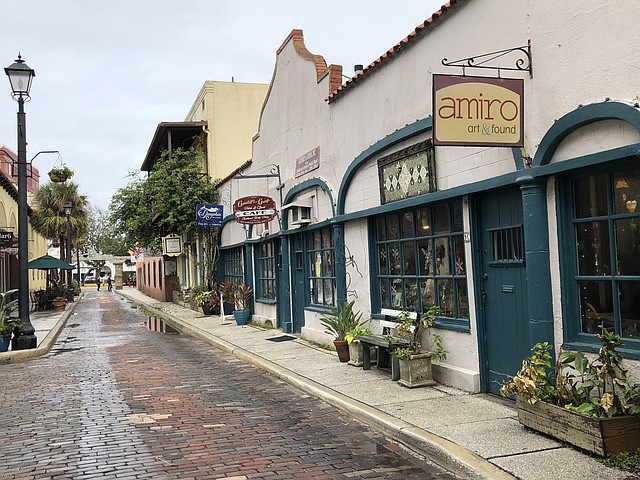
St. Augustine’s Old Town is another must-visit locale. This section of the city was the site of its first community and the link to its 16th century roots. It is remarkably preserved and resplendent with architectural landmarks, beautiful pocket gardens, interesting shops, eateries, galleries and accommodations. The narrow brick streets and walkways, stone walls and overhanging balconies create a distinctly European ambiance. In the heart of Old Town is Aviles Street, the oldest street in the nation and an original art district, as well as the location for an early church, historic well, cemetery, jail, hospitals, boarding houses and schools. The area exudes charm and authenticity and is a showcase of architecture with examples of Victorian, Medieval Revival and Spanish Revival styles.
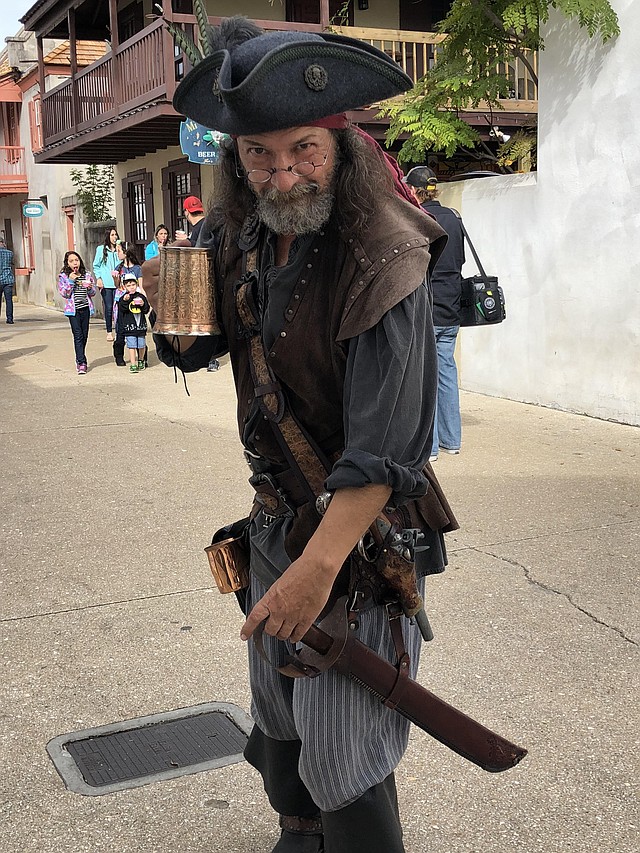
For an immersive journey through centuries of the town’s rich history, head to the Colonial Quarter, off of St. George Street. This two-acre living museum is devoted to showing life in the city in the 1740s. There are historic demonstrations, musket and cannon drills, tours of an authentic soldier’s house, print shop, blacksmith and more. You can climb to the top of a 17th century watchtower replica and dine and drink in 18th century style at the Bull and Crown (British fare) or the Taberna Del Caballo (tapas and Spanish favorites). Reenactors depicting soldiers and citizens from the time period are known to make occasional surprise visits while you dine.
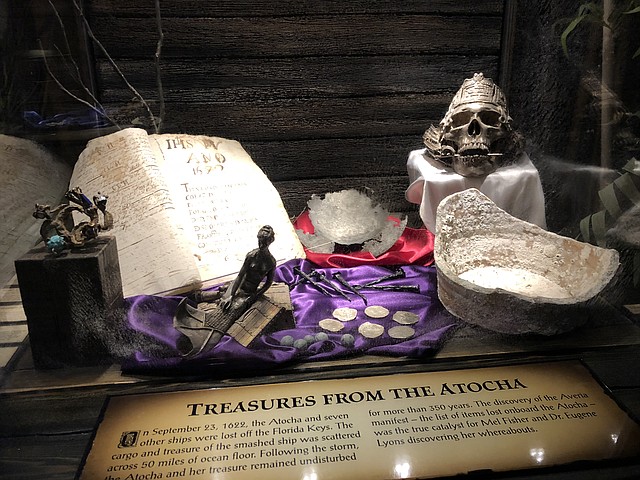
Adventure seekers will love the St. Augustine Pirate and Treasure Museum. The history of the city is tied to the grim and bloody reality of piracy in the 16th and 17th centuries when the rivalry between England and Spain led to attacks on each other’s shipping and settlements. St. Augustine was an important stop on the trade route, which made it a target for English privateers and pirates. Though you might initially think such a museum would be full of kitschy displays, you’ll be pleasantly surprised to learn there are a host of authentic artifacts on display, including a piece of Sir Francis Drake’s ship, Captain Kidd’s family bible, Thomas Tew’s original treasure chest, one of the three original Jolly Roger flags still in existence, the original of the first “Wanted” poster in the world, dating back to 1605, and the sword used by Johnny Depp in the “Pirates of the Caribbean” film. There are over 800 items and nearly two dozen interactive exhibits, as well as detailed written information on the history of piracy.
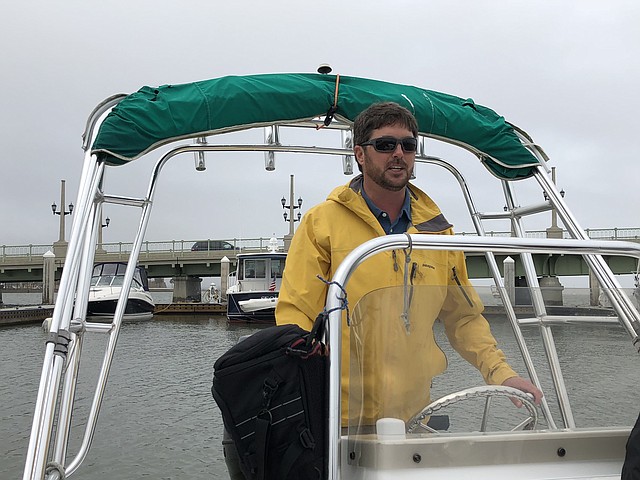
For some outdoor fun, explore the waterways with St. Augustine Eco Tours. The company offers boat tours, kayak excursions and catamaran sails on the inland waters surrounding the city, ranging from ninety minutes to two hours in duration. Owner Zach McKenna and his staff are interpretive naturalists, dedicated to the environment and passionate about sharing it with their guests. They will explain the elements of the estuary and introduce you to an array of fascinating creatures that might include double crested cormorants, brown pelicans, osprey, egrets, herons, and the ever-popular bottlenose dolphins.

You’ll come away with a plethora of information about animal behavior. The dolphins, for example, travel about ninety miles a day and never sleep. They also have the largest neocortex of all animals, making them the world’s second most intelligent creatures, with only humans displaying greater brainpower. “Peduncle” was Captain McKenna’s word of the day on my trip. This term refers to the muscular area or tail stock that provides the power behind the dolphin’s up and down swimming motion.
Anastasia Island, between the Intracoastal Waterway and the Atlantic Ocean is a vacationer’s paradise for all outdoor activities. Sandy beaches reign supreme here and the Anastasia State Recreational Area with its miles of nature trails is a haven for hikers, birders and campers. The island is also home to the St. Augustine Alligator Farm. It’s the world’s first of its kind zoological park with the only complete collection of crocodilians, not to mention, snakes, monkeys and birds.
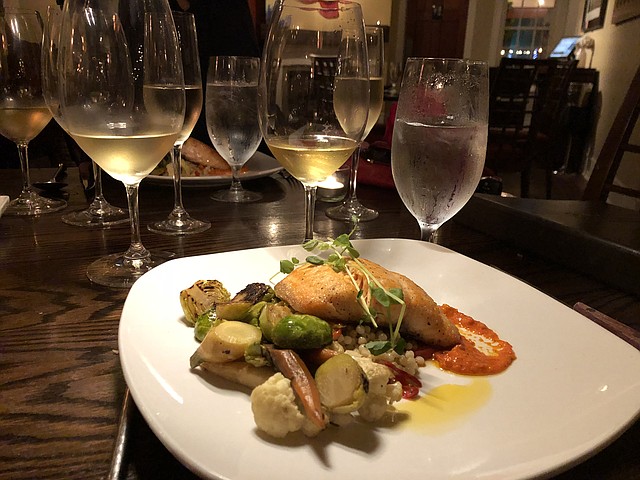
With all this activity, you’ll need sustenance. Not to worry, St. Augustine’s got you covered. Restaurants and bars dot the city and surrounding areas, offering a variety of cuisines. Head to intimate and trendy Catch 27 for some of the most delectable seafood in town. The establishment prides itself on preparing and serving fresh, locally caught seafood, and everything is made from scratch. Another special place is Michael’s Tasting Room, which emphasizes fresh, local and seasonal Spanish and Mediterranean inspired creations. This St. Augustine gem resides in a converted historic home dating back to 1764. Also memorable is lunch at Café Alcazar. This elegant eatery is situated in the Lightner Museum in a space originally designated for the largest indoor swimming pool of the Hotel Alcazar. The menu emphasizes entrees made from the freshest ingredients, local and organic. For great “fast seafood,” make a beeline for newly opened St. Augustine Seafood Restaurant in the Colonial Quarter. There you’ll feast on such dishes as conch fritters, spicy Minorcan clam chowder, shrimp tacos and freshly grilled fish. The restaurant even lists which boats brought in what seafood for the day.
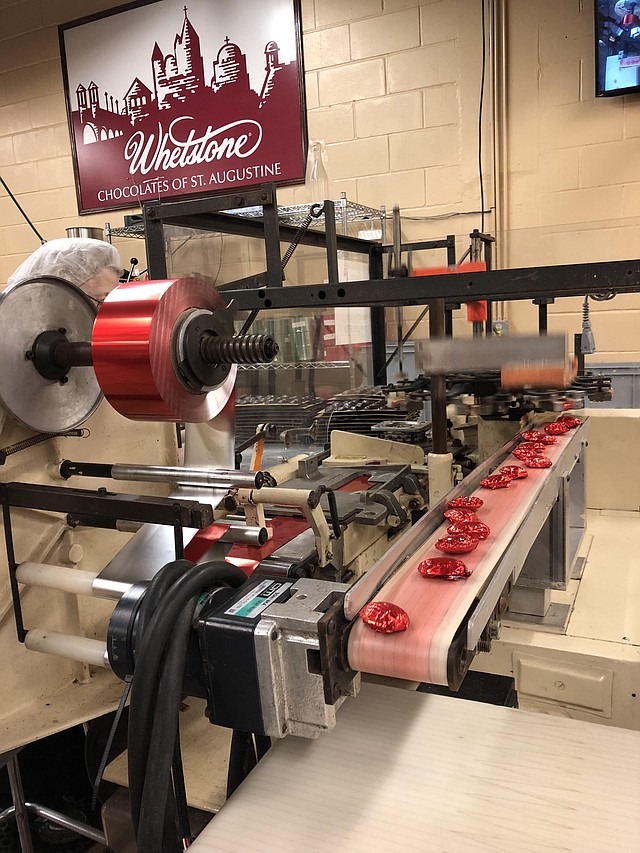
Food tours, which have become all the rage these days, are plentiful in St. Augustine. To appease your sweet tooth, check out Whetstone Chocolate Factory. You’ll be introduced to the history and making of chocolate, as well as to the Whetstone story. The best part is the four-tiered tasting, which brings out the characteristics of dark, milk and white artisan chocolates. It’s a decadently delicious experience!
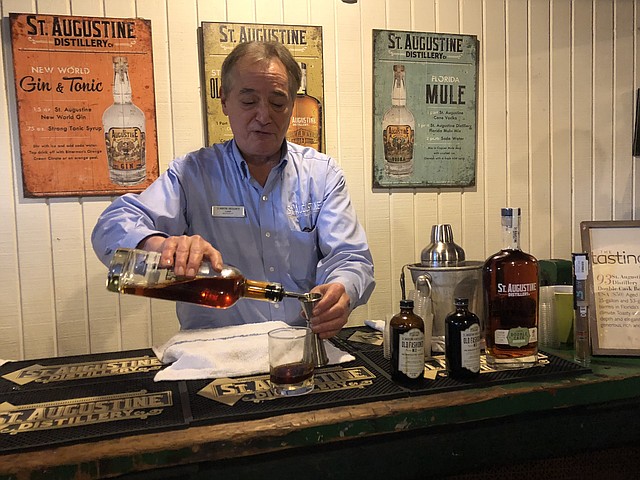
For aficionados of craft liquors, take a tour of the St. Augustine Distillery, which includes a visit to the company’s museum, distillery, barrel room and tasting bar. You’ll learn how locally grown Florida agricultural products are turned into award-winning vodka, gin, rum and bourbon. And of course, you’ll get to imbibe a variety of cocktails such as a Florida Mule, Rum Tiki and Old Fashioned. The building itself is notable, as it was Florida’s first commercial ice plant and dates back to 1917. The distillery has received much recognition for its preservation and restoration efforts, which accompany the many awards its spirits have earned.
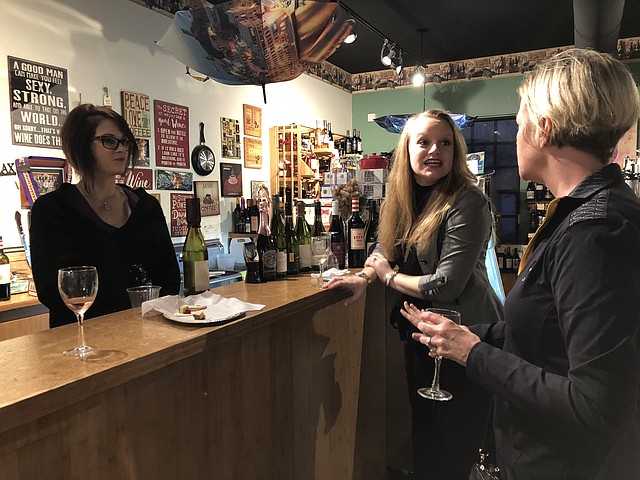
In the evening, join highly rated The Tasting Tours, for its Corks and Forks Tour. It’s a three-hour strolling experience where you eat and drink your way through St. Augustine. You’ll learn where the foodies like to dine, sample farm fresh ingredients in creatively prepared dishes and sip boutique wines, while exploring the city’s beautiful historic streets. If you’re lucky, you’ll get guide extraordinaire Donna Cowley, a St. Augustine native, who attended Flagler College. Donna is incredibly enthusiastic about her town and its food and wine culture, and is delighted to share her knowledge with visitors.
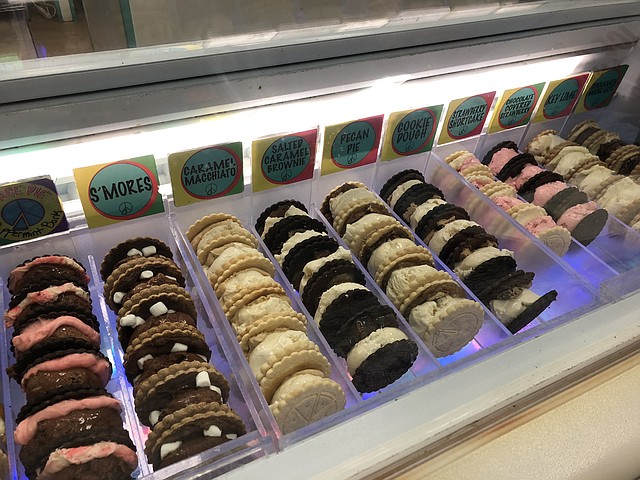
Our tour stopped at five establishments, including The Gifted Cork, a wine and gift boutique, where we tried a variety of different wines from Australia and New Zealand (the wine destination of the month), along with a few cheeses. At the Old City House, a well-known upscale establishment in an elegantly restored 19th century building, we were treated to a tasty dish of swordfish and crabmeat, followed by a sample of the restaurant’s NY style strawberry cheesecake. The Floridian was next on our “crawl.” This casual, popular restaurant focuses on high quality, local and sustainable ingredients in traditional Southern dishes with a twist. We sampled cornmeal dusted fried green tomatoes and cheesy polenta grit cakes. At Odd Birds, an eclectic neighborhood bar, where “chill” is the mantra, craft cocktails take center stage, along with a smattering of bites like ceviche bowls and yucca fries. The tour ends with dessert at Peace Pie, my favorite stop of the evening. This family run establishment has several locations in New Jersey, South Carolina and now Florida. Each Peace Pie has a layer of ice cream and another of pie filling that are anchored between two hearty shortbread cookies. Flavors abound with such delights as pecan pie, salted brownie, peanut butter chiffon, key lime pie, cookie dough, pumpkin latte, cinnamon bun and many, many more. These unique and ginormous ice cream sandwiches are simply amazing!
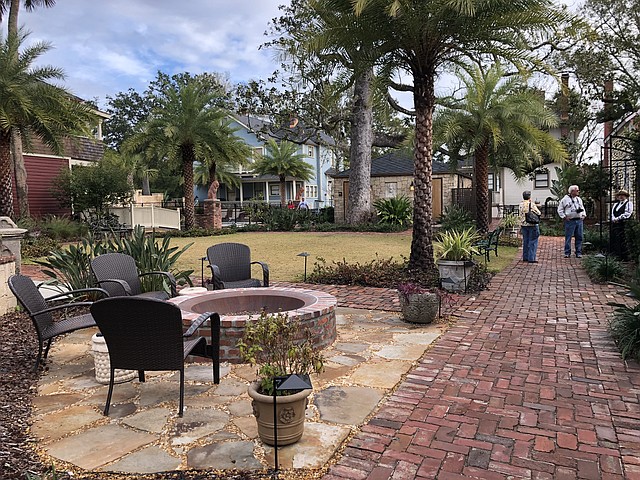
When it comes to accommodations, St. Augustine and the surrounding area offer a myriad of properties from full service resorts and boutique hotels to charming B&Bs and quaint, historic inns. I stayed at The Collector Luxury Inn & Gardens, a collection of nine historic houses conveniently located on the edge of Old Town. Once the home of St. Augustine’s Dow Museum of Historic Houses, The Collector Luxury Inn & Gardens weds contemporary luxury with impeccable historic preservation. Each of the property’s houses is different, as is each of the individual thirty rooms. All have been artfully and stylishly restored, and contain several historic features as coquina walls, original stained glass windows, refurbished hardwood floors and other period decor. These details blend seamlessly with such modern amenities as rainwater showerheads, flat-screen LCD HDTVs, luxurious bed linens, bedside interactive iPads and kitchenettes with microwaves and mini-fridges.
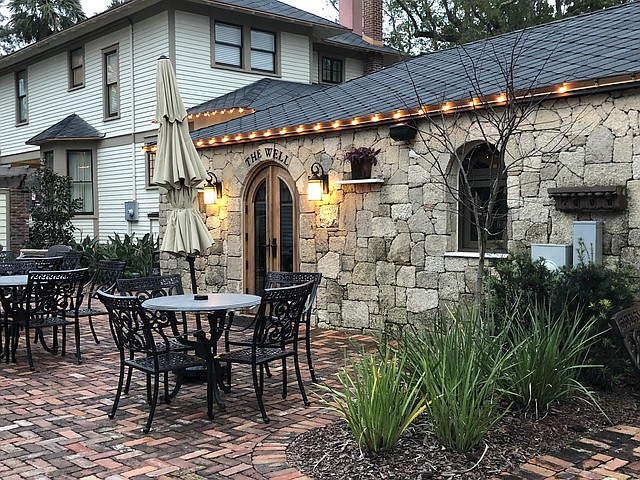
The property’s grounds comprise a one-acre oasis of live oaks, lush gardens, outdoor sculptures, stone fountains, wrought iron gates and brick pathways. Sit by one of the outdoor fire pits at night for the ultimate in cozy. And if you want a before or after dinner drink, stop in at The Well, an intimate gathering spot in what was once St. Augustine’s first two-car garage. You can opt for a classic cocktail or something totally unique like an herb-infused elixir made especially to your taste. In the morning, enjoy the European Continental breakfasts; later in the afternoon, munch on the snack offering of the day in the Star General Store. This building was constructed in 1899 by a local dry goods merchant and served as a general store. Today, it’s the lobby and reception area. The warm welcome you’ll receive at the inn is indicative of the gracious, southern hospitality you’ll be shown throughout your stay in the nation’s oldest city.
If you go:
For everything St. Augustine: http://www.floridashistoriccoast.com
The Collector Luxury Inn & Gardens: http://www.thecollectorinn.com
Debbie Stone is a travel writer and columnist, who explores the globe in search of unique destinations and experiences to share with her readers. She’s an avid adventurer who welcomes new opportunities to increase awareness and enthusiasm for travel and cross-cultural connections. Her stories appear in a number of print publications as well as on various travel-oriented websites, and she can also be heard on the radio dishing about travel with the hosts of Big Blend Radio. Debbie is a longtime Seattle area resident, who currently resides in Santa Fe, New Mexico.

